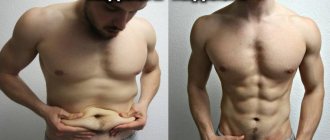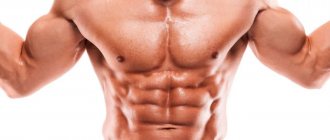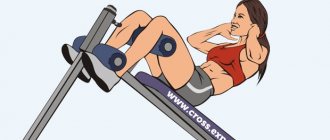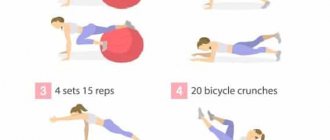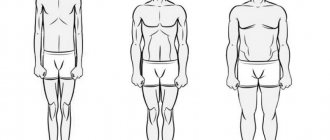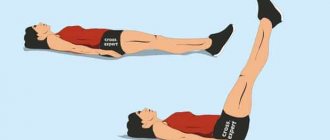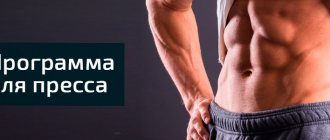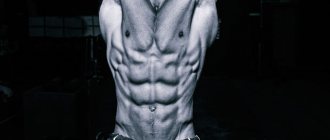First, the bad news: No matter how much physical effort you put into creating ripped abs - crunches, planks, squats, cardio, HIIT - no one will be able to see them if they are hidden under a layer of fat.
And now the good news: you can become the owner of a six-pack if you follow the right diet for your abs, which is good for the overall health of the body.
You may be familiar with the phrase “abs are made in the kitchen.” Well, this is 50% true – nutrition and exercise always go hand in hand; One without the other will “do”, but for a truly impressive result you will need a competent diet and training program for the abs. So, if you already have a healthy dose of exercise in the equation, all you need to do is get your diet in order, figure out what you shouldn't eat when you're doing abs, and what you should definitely add to your diet.
Below you will find tips on how to improve your diet to quickly achieve the desired six-pack or flat belly.
But before we get to the fun part, let's go over a few basic things about the waist:
Too much fat! Fat won't help you get abs
The first and most important reason is subcutaneous fat, which so skillfully hides our flat stomach. Yes, exactly, every person has abs, whether he is fat or thin, the most important question is how much subcutaneous fat our abs hide.
So, in order to see those same seemingly inaccessible abs, you first need to get rid of excess fat. This is achieved in two ways, which are connected by unbreakable love: diet and cardio training.
How to get rid of belly fat and how much body fat is normal
Losing excess fat from any area of your body has huge benefits for your health, but also for your self-confidence and self-satisfaction. Excess intra-abdominal (visceral) or subcutaneous fat is associated with an increased risk of developing insulin resistance, type 2 diabetes, or heart disease. [1]
- Visceral or intra-abdominal fat can be found in the abdominal cavity around the internal organs. Its excess is associated with a number of diseases, such as type 2 diabetes or heart disease.
- Subcutaneous fat is located in the subcutaneous tissue between the skin and muscles and can be easily felt by anyone in the form of a skin fold. Within normal limits, it is not associated with an increased risk of developing a number of civilization diseases and is thus an aesthetic problem rather than a health problem. [2–3]
What percentage of body fat is considered normal?
- For a healthy young person, the normal amount of body fat is about 20% of total body fat, but anything beyond that and we're starting to talk about obesity. [5]
- For a healthy young woman, the normal amount of body fat is up to about 30% of total body fat , any number above this and we start talking about excess weight. [5]
To pump up your abs, you need to eat right
The next step that will help you see your abs is nutrition. It's very simple: first you need to stop eating most of your carbohydrates. Stop eating fast foods, stop eating sweets (at least for these 3-4 months).
Give preference to slow carbohydrates: buckwheat, rice, oatmeal, bran porridge, rice, all kinds of nuts, as well as vegetables. Try to eat most of your carbohydrates in the first half of the day. The percentage of carbohydrates in the general diet should be around 25 - 30%, the remaining 70 - 75% is filled with proteins: eggs, meat, milk (in small quantities), sea fish, cottage cheese, protein shakes.
Here's a sample meal plan for you:
| TIME | EATING |
| 08:30 | Omelette of 4 - 5 egg whites and one yolk (you can add cheese and bacon) A couple of pieces of toast bread Multi-vitamin complex Fish oil |
| 12:00 | 150 - 200 g of meat, grilled or oven-cooked 200 -250 g of vegetable salad, without dressing Multi-vitamin complex Fish oil |
| 15:00 | 100 - 150 g of any porridge (oatmeal, buckwheat, bran) 150 -200 g of vegetable salad, without dressing 5 - 10 g of BCAA* |
| 18:00 | One serving of whey protein 150 - 200 g of grilled or oven-cooked meat 150 -200 g of vegetable salad, without dressing Multi-vitamin complex Fish oil |
| 21:00 | 200 g cottage cheese + some fruit 5 – 10 g BCAA* |
After all, is there anything you can do to burn belly fat?
One study examined whether fat storage matters in relation to the energetic coverage of movement. increased blood flow and lipolysis ("fat breakdown") were observed in the subcutaneous fat adjacent to the working muscle . But does this really resonate with everyday life? Unfortunately no. The increased effect of lipolysis was very minimal and quite insignificant in relation to general lifestyle and all factors that interfere with weight loss. [15]
Some work even suggests a small beneficial effect of strength training followed by cardio on desired weight loss in a specific area. Simply put, if you put more weight on your upper body during a strength training session and then do some cardio, you'll likely get a little more energy from the fat stores stored in the upper half of your body. Again, however, this effect is subject to all the conditions for successful weight loss and is rather a potential “biohack” method , the effect of which on local weight loss has not yet been sufficiently confirmed. On the other hand, if you do a few abdominal exercises during your workout, followed by 30 minutes of cardio, you will do absolutely nothing wrong, but rather benefit. [16-17]
When losing weight, the ratio of energy consumed and energy received is always selected. High-quality fat burners contain thermogenic substances that stimulate the body to produce more heat, which requires energy expenditure. Moreover, they contain substances that have a positive effect on inflammation and concentration. As a result, you can do more work during your workout, which leads to more calorie burning and a greater contribution to the weight loss puzzle. If you are interested in how to improve the effectiveness of your fat burner, read our article 6 tips to improve the effect of your fat burner.
The most effective abdominal exercises
Leg raises in parallel bars
Take a parallel bars position with your arms straight. The stand must be strong - the body should not sway during movement. Keep your back straight. Bend your legs slightly at the knees and raise them to a level parallel to the floor. Hold them at the top point for a couple of seconds, then smoothly lower them down.
"Lumberjack" kneeling
Attach a resistance band or use a crossover at a level just above your head in a lunge. Take a deep lunge position - standing on the knee of one leg. The second is bent at the knee and rests the foot on the floor. Pull the expander over your shoulder so that its end is near the opposite hip.
"Star"
Starting position – lying down. Next, put your hands forward and spread them as wide as possible, trying to find balance in this position. Your business should form something like a star shape. Tighten your abs so that your body does not sag down or protrude upward.
Raising the body with a barbell
Load the bar with a light weight and lie on the floor holding the bar overhead. In the starting position, hold the bar as if you were doing a bench press. Straighten your legs and leave them lying on the floor. They should not move throughout the entire exercise. Raise your body so that at the end point of the exercise it is perpendicular to the floor. The barbell at its extreme point should be in a position above your head.
V-lifts with medicine ball
Starting position: lying on the floor, legs and arms straightened, pointing at the ceiling. Hold the medicine ball with your arms outstretched. The shoulder blades and head should be pressed to the floor. Next, lift your shoulder blades off the floor, trying to reach your toes with the medicine ball.
V-shaped body lifts with fitball
Starting position: lying on the floor, arms and legs extended and lifted off the floor. The back, pelvis and shoulder blades are pressed tightly to the floor. A fitball is held between the shins of the legs. Simultaneously lift the pelvis and shoulder blades so as to transfer the fitball from your legs to your hands. Then, return to the starting position. Repeat the exercise, passing the ball from your hands to your feet and vice versa.
Weighted sit-ups
Starting position: lie on the floor, bend your knees and place them on the floor. The hands, at the same time, hold some kind of weight (pancake, barbell, disc, etc.) at chest level. Press your shoulder blades firmly to the floor. Raise your body so that your shoulder blade and lower back are off the floor. Pause at the extreme point for a second. Then, very slowly lower yourself down to the starting position.
Partial sit-ups with straight arms
Lie on the floor so that your back and shoulder blades are pressed firmly to the floor. Place your legs at a 90-degree angle and place your feet on the floor. In the initial position and throughout the entire approach, the arms are extended upward, towards the ceiling. Raise your body slightly so that your shoulder blades lift off the floor. Hold at the extreme point, then slowly lower to the starting position.
Running in place with a medicine ball
Stand in the “lying support” position, resting your hands on a medicine ball standing on the floor. In the initial position, the legs are extended and stand next to each other. Keep your back straight throughout the entire exercise. Pull one leg with your knee towards your chest. Then, return it to its original position, while simultaneously pulling up the second one. Perform the movement, simulating running in place.
Superman
Starting position: lying down, feet on a fitball. Pull the ball towards you with your feet so that your body is upright. Next, slowly roll the ball back and place your shins on it. The body should take a horizontal position, and the outstretched arms should be above the level of the head, but without violating the position of the emphasis on the floor. Using the strength of your abdominal muscles, return to the starting position, in which your arms are at shoulder level.
Leg raises on a bench with a medicine ball
Sit on a bench and grab the edge with your hands to ensure a stable body position. Tilt your body slightly back. Extend your legs so that they form a straight line with your body. Hold a medicine ball between your shins. With a simultaneous movement, lift your body forward, and at the same time pull your legs bent at the knees towards your chest.
Roll-outs with a gymnastic roller
Sit on your knees and hold the roller so that it is strictly below shoulder level. In the initial position, the emphasis is on the toes, knees, and roller. By tensing your abdominal muscles, roll the roller forward until you feel tension in your abdominal muscles. At the end point of the exercise, the arms should be completely straight. The number of support points does not change - the hips should not lie on the floor. Working exclusively with your core muscles, return to the starting position by rolling the roller back.
Rollouts with a barbell
Place 5kg weight plates on a long barbell. Get on your knees and place your hands on the barbell. In the starting position, it should be below shoulder level. There are three supports: toes, knees and barbell. Roll the barbell forward until you feel tension in your abdominal muscles and until your hips begin to sag. Using your abdominal muscles, roll the barbell back and return to the starting position.
"Lumberjack" standing
Place the crossover handle at approximately shoulder level. Stand sideways to the machine. In the starting position, the body stands straight, and the body is turned slightly towards the simulator. The handle is held with two hands. Place your feet shoulder-width apart. You must stand at such a distance from the machine that the cable is taut. Moving exclusively with your body, turn so that your body is completely facing in front of you. The legs remain motionless throughout the entire exercise.
Body twists with medicine ball
Sit on the floor, tilt your body slightly back. Hold the medicine ball with your arms extended forward. Bend your legs at the knees and place them on the floor so that your heels only rest on the floor. Starting position – hands in front of you. Next, turn your body to the left side until your lateral abdominal muscles are stretched to the maximum. Return to the starting position and repeat on the other side. Movement is carried out only by the body - the pelvis and legs are tightly pressed into the floor and do not move.
Plank with circular movements
Rest your elbows and forearms on the exercise ball. Place your feet on the floor and press your toes into the floor. The body should be in a straight line - do not bend or arch at the lower back. Keep your abdominal muscles constantly tense. Moving your elbows, rotate the fitball first clockwise, then counterclockwise.
Which part of the body loses fat first when losing weight?
Just as you can't control where your fat is stored, you can't control where your body breaks it down first. Primarily, many people store fat around their belly, which is mainly due to lower testosterone levels and increased levels of the stress hormone cortisol. Women tend to be more prone to storing fat on their thighs and buttocks, which they can thank to the associated female sex hormone estrogen. [9-10]
Hormones, genetics and general lifestyle complicate the problem. Some are lucky enough to win the lottery genetically, and fat is gradually stored and eliminated from the body.
Therefore, there is no point in trying to lose weight in one specific place on the body , because it is simply impossible. Personally, we really like the comparison of localized weight loss to a swimming pool and a bucket of water: “Trying to lose weight on a specific part of the body by exercising more frequently (like the abdomen) is like emptying a bucket of water from just one corner of the pool.”
A short summary
Change your diet: Eat more protein than carbohydrates. Try to eat only slow carbohydrates (porridge, vegetables, nuts). Use cardio exercises 3 – 4 times a week: this can be running, cycling or cardio exercises at home. And of course, don’t forget to pump up your abs using the Ab Ripper X program.
We looked at the main points that will help you achieve a sculpted belly and finally see your abs.
If something remains unclear to you, ask your questions in the comments. Rate this article
Frequency of training
Will doing abs get rid of your belly fat? - No. The press does not help to remove the belly. However, in order for the skin on the abdomen to be tightened and the body to look slimmer, training is necessary. You need to perform training exercises and gymnastics regularly in order to see results as soon as possible.
The first type of training required is cardio. They are necessary for the fat burning process, as they are aimed at burning calories. They are also useful for increasing stamina.
Research results
From the table below, you can see that abdominal training did not result in any statistically significant changes in body weight, total fat mass, or android fat mass. Android fat is fat in the torso: around the abdomen, chest, shoulders, neck and back. However, by the end of the sixth week, the subjects were able to do more repetitions at higher intensity, meaning they became stronger and more efficient, which is quite predictable.


